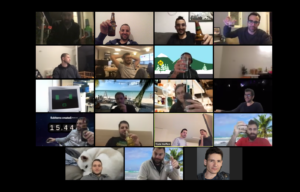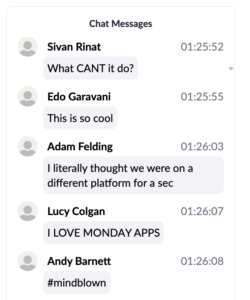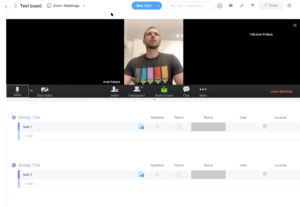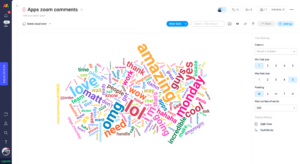Earlier in February, we announced monday 2.0, a strategic update to our platform, transforming monday.com into a Work OS. Part of monday 2.0 included the preview monday Apps—the ability for any team using monday.com Work OS to build their own features, integrations, and apps on top of our platform.
To get monday Apps ready for release, our product team organized a 2-day hackathon to test the monday App’s foundations — we wanted to ensure that anyone who would be interested in custom building their own app, had all of the infrastructure and tools needed to do so successfully.
And then… things changed.
With the outbreak of the Coronavirus, the entire monday.com office transitioned into WFH status.
Luckily for us, we were able to pull it off, leveraging the opportunity to completely transform our product roadmap to better support our customers working from home.
Here’s how we did it, and what we learned along the way.
monday Apps: opening up our platform to let customers build what they want
A bit of background context first.
monday.com is a versatile Work OS, containing building blocks – things like views, charts, automations, and integrations – that we have built for teams to create and shape the workflows that fit their exact needs.
monday Apps adds a new and exciting level of flexibility to our Work OS. Now developers can build and package their own building blocks, which they can then use to assemble custom apps – creating endless possibilities for innovation.
The goals, teams and process: our approach to the hackathon
While figuring out the operational challenges of our remote hackathon, we understood that we needed to shift our product priorities. We needed to enhance our Work OS with features that would better support our customers working from home.
So, we decided to quickly shift the focus of the entire hackathon to building Apps that would help remote teams work, collaborate, and stay informed, no matter where they are.
We were determined to deliver immediate value to our customers, as they transition to working from home.
After pooling the most highly requested remote-work app ideas from customers and monday employees, we created 20 teams, each with representation from design, product, and engineering, and suggested apps for each team.
With 80 engineers and designers cleared of meetings and ideas flowing—we were ready to go.
We started off with our typical structure:
-
The goal
Each team was given a general idea of a View or Widget that could be valuable to build. The teams were therefore given full ownership and creative autonomy to adapt their final product to fit their vision.
-
The virtual teams
We created cross-functional teams with people who don’t normally get a chance to work together. The chance to work with new team members introduces unique creativity and problem-solving that can sometimes get lost in the day-to-day routine.
-
The process
For all our previous hackathons the process looked something like this:
- Opening talk to align on goals
- Sit together in groups for the day, collaborate and create
- Review the day’s work over pizza and beer
While our goals and teams wouldn’t change much —our process certainly would in order to adapt to WFH.
Adapting to remote work
One of the most unique parts of running a hackathon is the undivided attention you receive from everyone involved.
Team members are wholly focused on a single goal: they sit together, eat together, and try to pull this crazy thing off.
Our main concern when transitioning this hackathon remote was losing the immeasurable value that comes from having a bunch of highly motivated people sitting in a room together. That concern is only magnified when you consider that these are teams made up of people who don’t usually work together—so there is an extra barrier of understanding how others work and think.
So we realized we needed to figure out a way to simulate our togetherness – while being apart.
Simulating togetherness with digital tools
- Zoom rooms for quick check-ins
We opened Zoom rooms for each team to keep open to enable them to quickly ask questions, collaborate, and bounce ideas off of one another without having to individually schedule calls and reach out to each other. Zoom rooms with the hackathon organizers were also available for anyone who wanted to drop in throughout the day to ask questions, share exciting updates, or just to chat. - Slack channel for motivation and chitchat
A Slack channel was opened for all of the teams participating in the hackathon to share updates and keep everyone excited and motivated for what they were working on.
Allowing everyone to feed off of each others’ excitement around what they were working on was a crucial element in keeping everyone engaged and ultimately, the success of the hackathon. - Setting a schedule to maintain consistency
The opening talk, happy hour (BYOB of course), and closing talk, where everyone shared what they created, all stayed the same— we just transitioned them over Zoom.
Keeping the schedule that everyone had become accustomed to helped to keep some consistency in the otherwise abnormal setting.

Staying organized
When you are working with a large distributed team who are all trying to execute impactful projects, making ownership and deadlines clear is more crucial than ever.
You can check out the monday.com board that we created to organize our hackathon teams, present ideas, and bring the hackathon to life!
Sharing the glory
After the teams created their apps and shared it amongst the rest of the hackathon group, it was time to share it with the company. Over 350 monday.com employees attended the live Zoom meeting to see the hackathon outcomes.
Let’s just say, the feedback got a little out of control.

Takeaways
Pulling off a 2-day hackathon that involves the time and investment of multiple teams is never easy, but doing it remotely brought on new challenges. By keeping our schedule but adapting it for WFH using digital tools, we were able to create room for feedback and enable cross-team collaboration.
There were also advantages that came from a remote hackathon—with everyone accustomed to working alone, the opportunity to work with such a close-knit team was a welcomed change, bringing some of the best results from a hackathon to date:
- 20 new monday apps
- 18 widgets created
- 15 new views
- 18 slack channels opened
- 20 hours spent in Zoom rooms
The time these apps will save monday.com customers.. Priceless.
Results…drum rolls please
Without giving away too much… here is a sneak peak at what our teams created over the past 2 days that you can expect to see on your monday.com account in the coming weeks:
Embed Zoom calls within a board
If this isn’t the holy grail of remote-work then I don’t know what is. You can now host a Zoom call directly within a board. Invite everyone on the board, enter the call number, and collaborate in every way over one shared space.

Work status dashboard
Understand at a glance where your team is working with a clear view of the working status of everyone on your team!

Word cloud creator
Create a word cloud from any data! Here we took the Zoom chat from our Apps announcement meeting to see what everyone thought. I think you get the idea.

We’re busy testing the other 15 Apps and getting everything production-ready.
So, stay tuned to keep track of the amazing product updates live for you to use!

